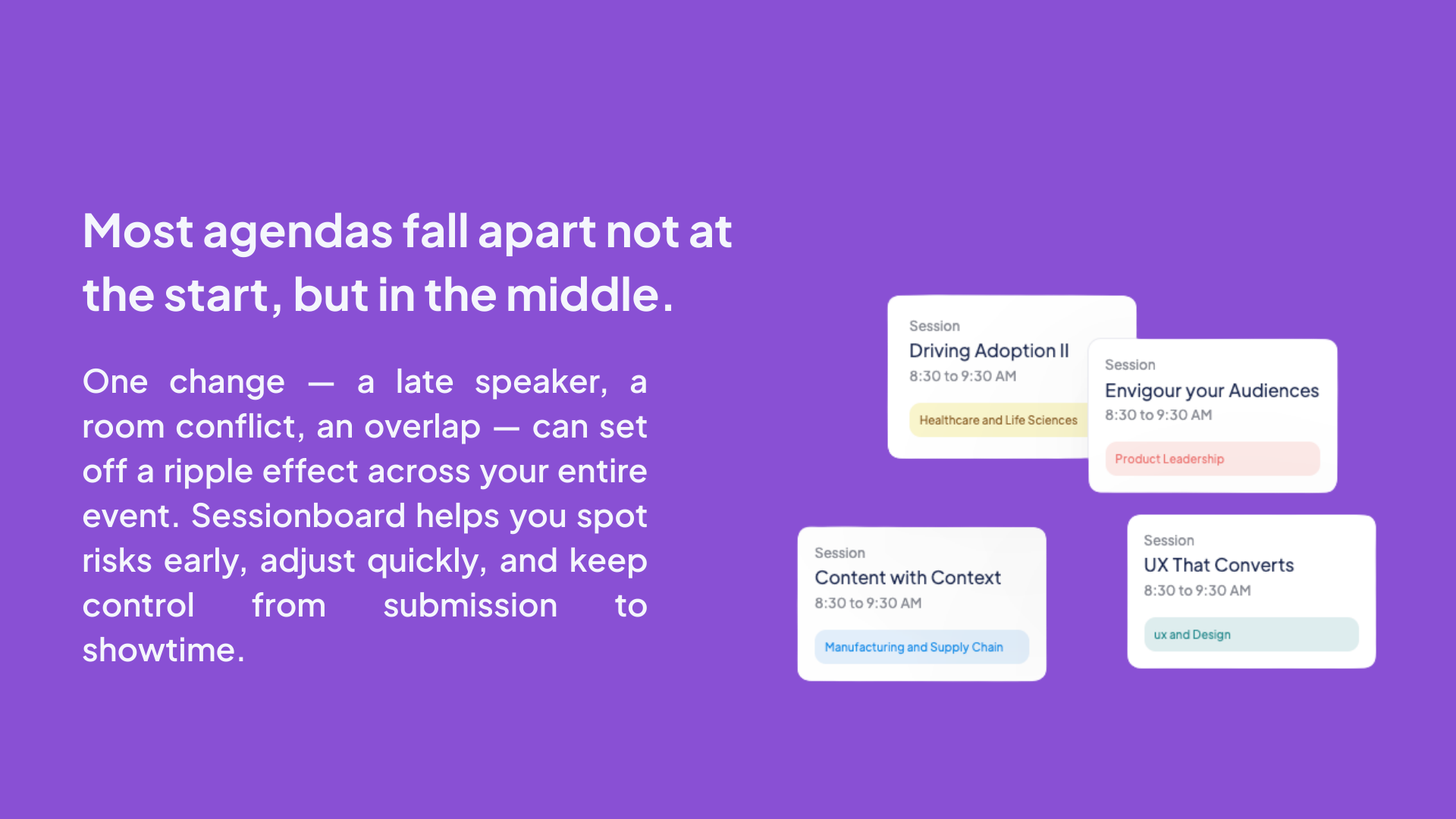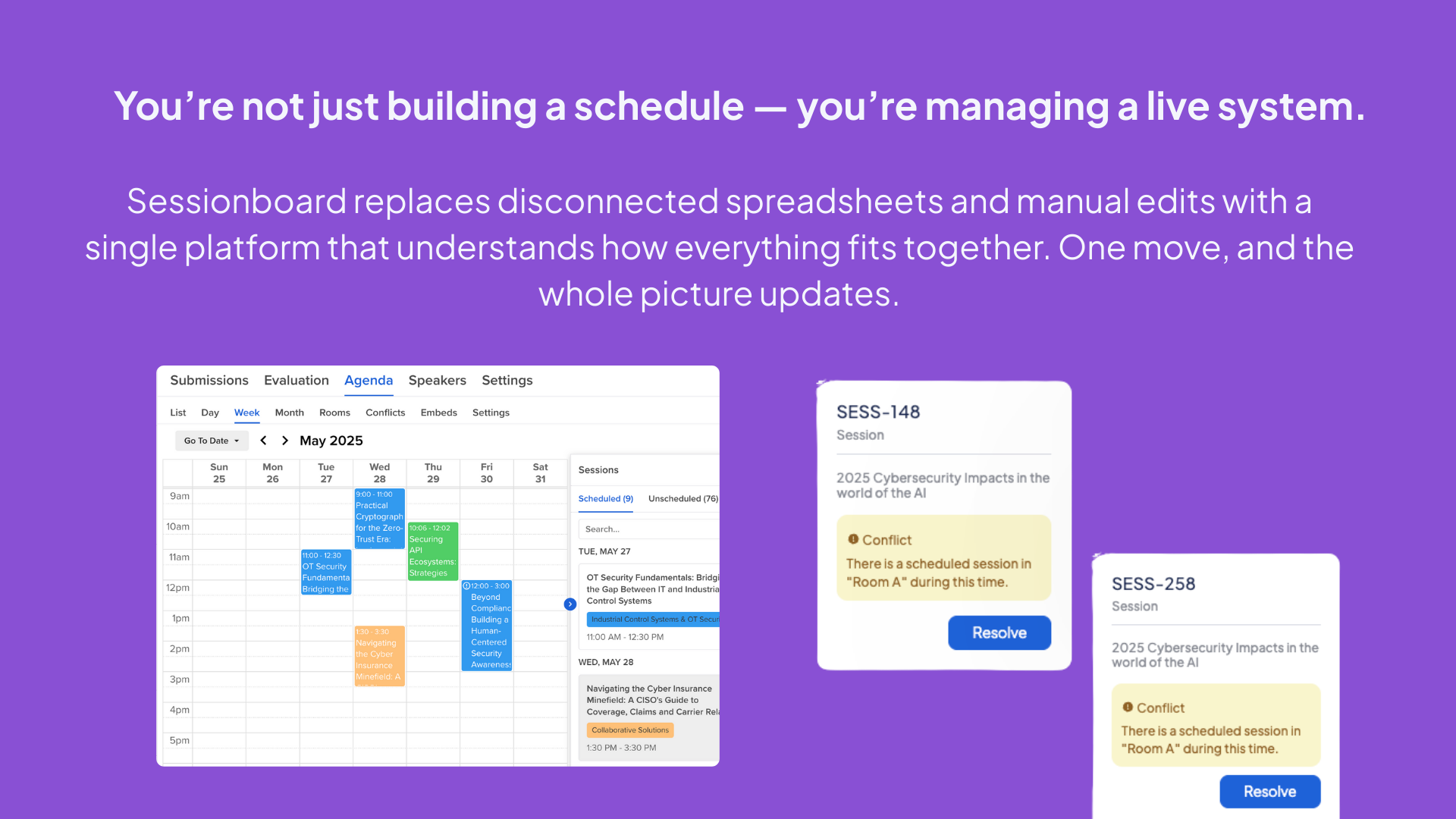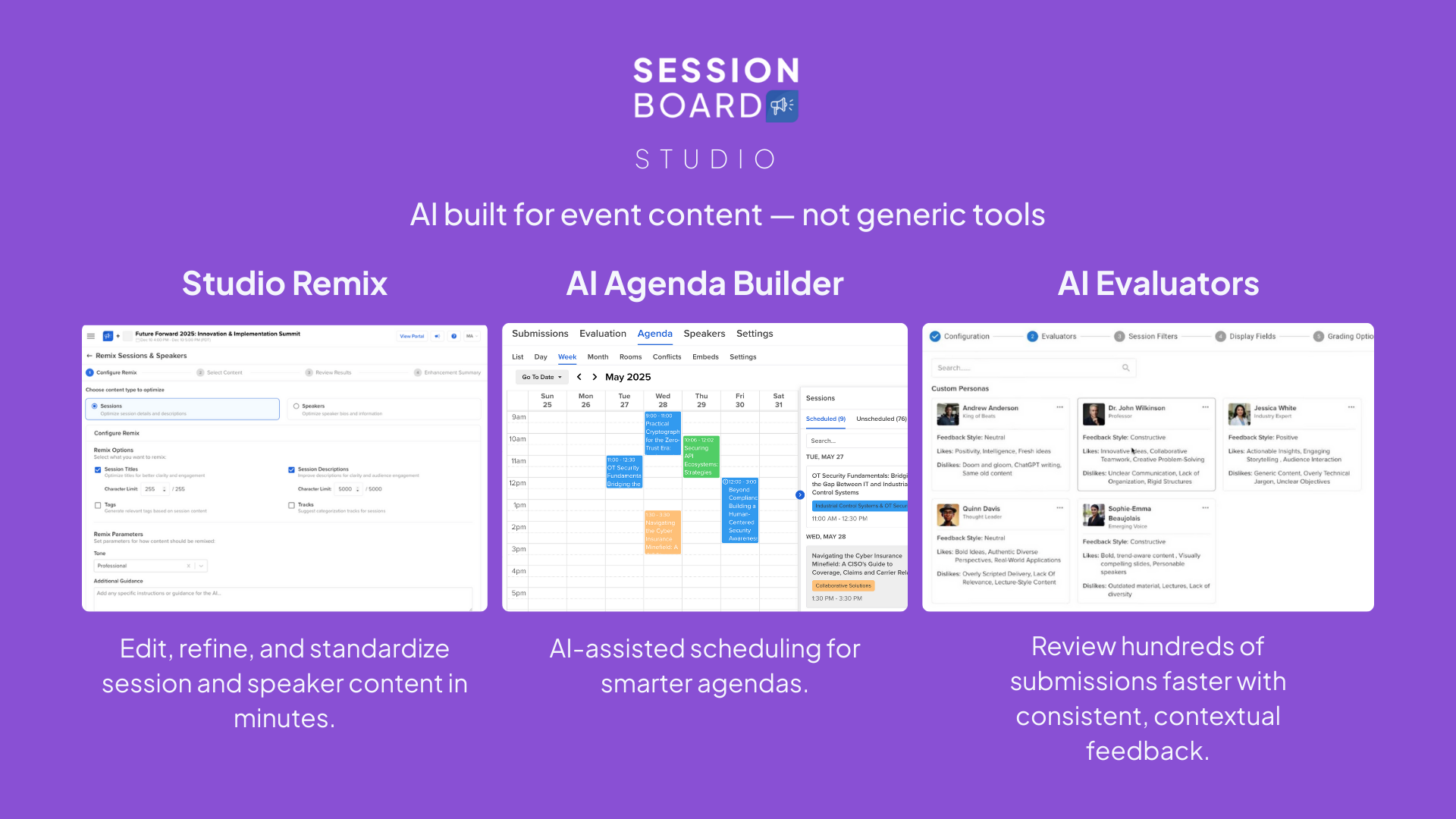What a Speaker CRM Unlocks for 2026 Planning
Why 2026 Planning Starts With Your Speakers

.png)
.png)
If you have ever built an event agenda, you know it is never just about slotting sessions into a calendar. It is more like solving a constantly moving puzzle. Every piece has to fit together in a way that works for speakers, attendees, sponsors, and staff all at the same time. A single misplaced detail can create gaps, overlaps, or conflicts that throw the whole picture off balance.
Event professionals told us they always start with the basics: making sure every session has a date and time, that speaker details are accurate, that rooms are available, and that the content mix is diverse enough to meet audience expectations. But even with those boxes checked, things rarely stay stable for long. Speakers update their availability. Rooms change configurations. Session topics overlap more than expected. And just like that, what looked good on paper turns into a chain reaction of changes. Many planners call this the domino effect—a single adjustment that sets off a ripple across the entire schedule.
The impact is real. A late speaker or a room setup delay does not just affect one session. It can create confusion for attendees, leave staff scrambling to communicate updates, and undo hours of careful preparation. And the more complex the program, the faster those ripples spread.
The truth is, these challenges are not the result of poor planning. They stem from the inherent complexity of managing hundreds of details in a live environment where change is constant. One shift rarely impacts just one line on the schedule—it often affects multiple sessions, teams, and workflows at once. That is why agenda management is so demanding, and why relying on spreadsheets or manual coordination often leaves teams vulnerable to last-minute chaos.
Building an agenda is not just about assigning time slots. It is about balancing hundreds of variables at once while preparing for the reality that change will come.
Most teams today rely on spreadsheets, shared docs, or basic project management tools to coordinate. Those systems might capture data, but they lack the intelligence to show how one change affects everything else. That is why planners spend so much time double-checking and manually updating. If a speaker cancels, you are not only finding a replacement but also confirming the new slot, updating the session page, adjusting room assignments, and notifying attendees. Each of those steps usually lives in a different tool, which means a lot of rework and a higher chance of mistakes.
Event professionals told us the real frustration comes from the domino effect. Small changes—like a speaker running late or an overlapping topic—can set off a chain reaction. Without tools that understand the unique context of events, teams are left firefighting instead of staying focused on the bigger picture.
This is exactly why Sessionboard includes purpose-built agenda management tools. The platform brings all the moving parts together into one system so you can plan smarter and react faster. Features like drag and drop scheduling, conflict flagging, room setup details, and advanced metadata views make it easier to see the full picture and avoid surprises. Instead of juggling multiple files and platforms, you get a single workspace designed for how events actually work.

Anyone who has ever built an event agenda knows it is more than filling in slots on a calendar. Each change has to work for speakers, attendees, sponsors, and staff all at once. That is why Sessionboard treats the agenda as a living system instead of a static document. With drag and drop tools you can move sessions around quickly as plans shift. Conflict flagging helps you spot speaker overlap or timing issues before they cause confusion. Quick edit options let you adjust session titles, abstracts, and metadata without leaving the agenda view.
Sessionboard also goes deeper than just scheduling. You can configure room setups, adjust time durations, and see the live status of every session at a glance. Unscheduled sessions can be managed in calendar view so they are always ready to slot in. Expanded profiles keep every session’s details in one place, including files, tasks, and speaker information. You can even publish your agenda directly to websites or apps using live embeds so attendees always see the most accurate version without the need for manual updates. Together these tools replace scattered spreadsheets with one connected workspace that puts every piece of your program within reach.

Even with powerful tools, every planner knows the hardest part of agendas is not building them but managing the changes that inevitably come. A keynote running late, a last minute cancellation, or a high demand topic that pulls too many people into a small room can unravel even the most carefully designed schedule. Event professionals describe this as the domino effect. One adjustment does not stay contained. It ripples across sessions, audiences, and resources, creating stress for teams and confusion for attendees.
This is exactly where AI has the potential to transform the process. Imagine a system that continuously monitors your agenda and alerts you to risks before they escalate. It could flag when a speaker is double booked, when a moderator is scheduled back to back without a break, or when two sessions with overlapping topics are competing for the same audience segment. It could suggest moving a session to a larger room if interest is high, or recommend spacing out sessions by track to balance the program flow.
The purpose is not to replace human judgment. It is to act as a co-pilot, scanning thousands of variables and surfacing the ones that matter most so you can make informed decisions faster. By catching issues early and suggesting possible solutions, an AI Agenda Assistant would allow teams to focus less on firefighting and more on creating programs that engage, inspire, and deliver value. This is the vision we are exploring at Sessionboard: giving event professionals a partner that helps them manage complexity without losing control.
Agenda management today already benefits from tools like conflict detection, drag and drop scheduling, and live embeds. Tomorrow it will also include intelligent assistance that helps you anticipate problems and act on them in real time. This is part of our larger vision with Sessionboard Studio, where features like AI Evaluators and Studio Remix already show how AI can save time and improve quality without adding more work. The AI Agenda Assistant is the natural next step. By combining automation with human judgment, Sessionboard aims to give event professionals one connected workspace where every piece of content, every speaker, and every schedule detail is managed with confidence.

Building an agenda is only one part of managing event content. The real challenge is keeping speakers, sessions, and workflows aligned across every stage of planning. That is why Sessionboard is designed as a single workspace that connects everything — from submission and evaluation to agenda planning, speaker portals, and content reuse. At the heart of Sessionboard is the Speaker CRM, giving you a complete history of every speaker across every event. You can track past sessions, tags, and communications so your team is never starting from scratch. Paired with Global Search and live dashboards, this gives you instant visibility into the people and content that matter most.
Because Sessionboard integrates with the rest of your event tech stack, from registration systems to webinar platforms, your data flows seamlessly across tools without manual re-entry. With Sessionboard Studio’s AI powered assistants, you have a platform that reduces repetitive work, strengthens collaboration, and helps you deliver a polished attendee experience.
Instead of piecing together spreadsheets, forms, and disconnected tools, you get one system built for the full content lifecycle. The result is more control, less busywork, and better events.
Ready to see how it works in action?
If you have ever built an event agenda, you know it is never just about slotting sessions into a calendar. It is more like solving a constantly moving puzzle. Every piece has to fit together in a way that works for speakers, attendees, sponsors, and staff all at the same time. A single misplaced detail can create gaps, overlaps, or conflicts that throw the whole picture off balance.
Event professionals told us they always start with the basics: making sure every session has a date and time, that speaker details are accurate, that rooms are available, and that the content mix is diverse enough to meet audience expectations. But even with those boxes checked, things rarely stay stable for long. Speakers update their availability. Rooms change configurations. Session topics overlap more than expected. And just like that, what looked good on paper turns into a chain reaction of changes. Many planners call this the domino effect—a single adjustment that sets off a ripple across the entire schedule.
The impact is real. A late speaker or a room setup delay does not just affect one session. It can create confusion for attendees, leave staff scrambling to communicate updates, and undo hours of careful preparation. And the more complex the program, the faster those ripples spread.
The truth is, these challenges are not the result of poor planning. They stem from the inherent complexity of managing hundreds of details in a live environment where change is constant. One shift rarely impacts just one line on the schedule—it often affects multiple sessions, teams, and workflows at once. That is why agenda management is so demanding, and why relying on spreadsheets or manual coordination often leaves teams vulnerable to last-minute chaos.
Building an agenda is not just about assigning time slots. It is about balancing hundreds of variables at once while preparing for the reality that change will come.
Most teams today rely on spreadsheets, shared docs, or basic project management tools to coordinate. Those systems might capture data, but they lack the intelligence to show how one change affects everything else. That is why planners spend so much time double-checking and manually updating. If a speaker cancels, you are not only finding a replacement but also confirming the new slot, updating the session page, adjusting room assignments, and notifying attendees. Each of those steps usually lives in a different tool, which means a lot of rework and a higher chance of mistakes.
Event professionals told us the real frustration comes from the domino effect. Small changes—like a speaker running late or an overlapping topic—can set off a chain reaction. Without tools that understand the unique context of events, teams are left firefighting instead of staying focused on the bigger picture.
This is exactly why Sessionboard includes purpose-built agenda management tools. The platform brings all the moving parts together into one system so you can plan smarter and react faster. Features like drag and drop scheduling, conflict flagging, room setup details, and advanced metadata views make it easier to see the full picture and avoid surprises. Instead of juggling multiple files and platforms, you get a single workspace designed for how events actually work.

Anyone who has ever built an event agenda knows it is more than filling in slots on a calendar. Each change has to work for speakers, attendees, sponsors, and staff all at once. That is why Sessionboard treats the agenda as a living system instead of a static document. With drag and drop tools you can move sessions around quickly as plans shift. Conflict flagging helps you spot speaker overlap or timing issues before they cause confusion. Quick edit options let you adjust session titles, abstracts, and metadata without leaving the agenda view.
Sessionboard also goes deeper than just scheduling. You can configure room setups, adjust time durations, and see the live status of every session at a glance. Unscheduled sessions can be managed in calendar view so they are always ready to slot in. Expanded profiles keep every session’s details in one place, including files, tasks, and speaker information. You can even publish your agenda directly to websites or apps using live embeds so attendees always see the most accurate version without the need for manual updates. Together these tools replace scattered spreadsheets with one connected workspace that puts every piece of your program within reach.

Even with powerful tools, every planner knows the hardest part of agendas is not building them but managing the changes that inevitably come. A keynote running late, a last minute cancellation, or a high demand topic that pulls too many people into a small room can unravel even the most carefully designed schedule. Event professionals describe this as the domino effect. One adjustment does not stay contained. It ripples across sessions, audiences, and resources, creating stress for teams and confusion for attendees.
This is exactly where AI has the potential to transform the process. Imagine a system that continuously monitors your agenda and alerts you to risks before they escalate. It could flag when a speaker is double booked, when a moderator is scheduled back to back without a break, or when two sessions with overlapping topics are competing for the same audience segment. It could suggest moving a session to a larger room if interest is high, or recommend spacing out sessions by track to balance the program flow.
The purpose is not to replace human judgment. It is to act as a co-pilot, scanning thousands of variables and surfacing the ones that matter most so you can make informed decisions faster. By catching issues early and suggesting possible solutions, an AI Agenda Assistant would allow teams to focus less on firefighting and more on creating programs that engage, inspire, and deliver value. This is the vision we are exploring at Sessionboard: giving event professionals a partner that helps them manage complexity without losing control.
Agenda management today already benefits from tools like conflict detection, drag and drop scheduling, and live embeds. Tomorrow it will also include intelligent assistance that helps you anticipate problems and act on them in real time. This is part of our larger vision with Sessionboard Studio, where features like AI Evaluators and Studio Remix already show how AI can save time and improve quality without adding more work. The AI Agenda Assistant is the natural next step. By combining automation with human judgment, Sessionboard aims to give event professionals one connected workspace where every piece of content, every speaker, and every schedule detail is managed with confidence.

Building an agenda is only one part of managing event content. The real challenge is keeping speakers, sessions, and workflows aligned across every stage of planning. That is why Sessionboard is designed as a single workspace that connects everything — from submission and evaluation to agenda planning, speaker portals, and content reuse. At the heart of Sessionboard is the Speaker CRM, giving you a complete history of every speaker across every event. You can track past sessions, tags, and communications so your team is never starting from scratch. Paired with Global Search and live dashboards, this gives you instant visibility into the people and content that matter most.
Because Sessionboard integrates with the rest of your event tech stack, from registration systems to webinar platforms, your data flows seamlessly across tools without manual re-entry. With Sessionboard Studio’s AI powered assistants, you have a platform that reduces repetitive work, strengthens collaboration, and helps you deliver a polished attendee experience.
Instead of piecing together spreadsheets, forms, and disconnected tools, you get one system built for the full content lifecycle. The result is more control, less busywork, and better events.
Ready to see how it works in action?

Stay up to date with our latest news
See how real teams simplify speaker management, scale content operations, and run smoother events with Sessionboard.